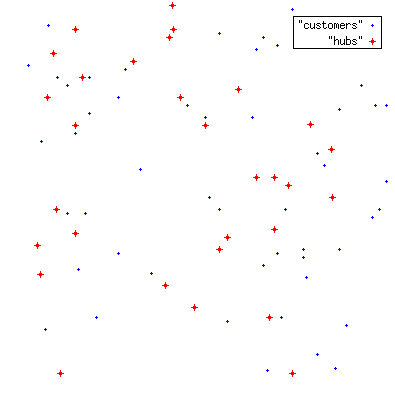Students who attended Jenny Ryan's talk on U S West's network problems might like to try their hand at the sort of problem the applied mathematicians at the phone company deal with.
Design a network with the following specifications. The prize goes to the student who achieves the lowest cost.
There are two types of points: hubs and customers. Your job is to select a set of hubs to be used, and an order in which to connect the hubs. Then fiber will we laid to accomplish two things:
- Each customer will be connected to the nearest of the selected hubs.
- The hubs will be connected to each other in a ring in the specified order (so that the breaking of an inter-hub connection will not affect communication; these inter-hub connections cannot go via a customer - they must be direct, hub-to-hub).
- The cost of each hub is $500; thus the total hub-cost is 500*n where n is the number of hubs you select.
- The cost per mile of fiber is $1000.00; the scale is 1 mile = 0.01 units.
Example: If you choose {17, 20, 14, 13, 19}, then the inter-hub fiber goes from 17 to 20 to 14 to 13 to 19 and back to 17, and the total cost of the entire network works out to be $15,281.

Hub data
1 0.85 0.61 2 0.16 0.79 3 0.036 0.37 4 0.43 0.74 5 0.1 0.05 6 0.064 0.74 7 0.56 0.39 8 0.09 0.46 9 0.85 0.49 10 0.4 0.89 11 0.39 0.27 12 0.74 0.052 13 0.47 0.22 14 0.64 0.54 15 0.68 0.19 16 0.082 0.85 17 0.14 0.67 18 0.69 0.41 19 0.14 0.4 20 0.41 0.97 21 0.59 0.76 22 0.73 0.52 23 0.045 0.3 24 0.54 0.36 25 0.79 0.67 26 0.3 0.83 27 0.41 0.91 28 0.69 0.54 29 0.5 0.67 30 0.14 0.91
Customer data
1 0.67 0.058 2 0.72 0.46 3 0.89 0.17 4 0.78 0.29 5 0.64 0.86 6 0.7 0.87 7 0.14 0.65 8 0.54 0.46 9 0.81 0.6 10 0.83 0.57 11 0.98 0.46 12 0.63 0.69 13 0.54 0.9 14 0.26 0.35 15 0.45 0.72 16 0.86 0.065 17 0.047 0.63 18 0.066 0.92 19 0.058 0.16 20 0.35 0.3 21 0.12 0.45 22 0.5 0.69 23 0.77 0.36 24 0.011 0.82 25 0.87 0.71 26 0.093 0.79 27 0.77 0.34 28 0.32 0.56 29 0.28 0.81 30 0.12 0.77 31 0.96 0.44 32 0.17 0.45 33 0.71 0.19 34 0.81 0.098 35 0.51 0.49 36 0.56 0.18 37 1. 0.53 38 0.7 0.35 39 0.87 0.36 40 0.15 0.31 41 0.2 0.19 42 0.93 0.77 43 1. 0.72 44 0.18 0.79 45 0.26 0.74 46 0.97 0.72 47 0.74 0.96 48 0.18 0.7 49 0.66 0.89 50 0.66 0.32
© Copyright 1996 Stan Wagon, except for the picture, which is in the public domain. Reproduced with permission.